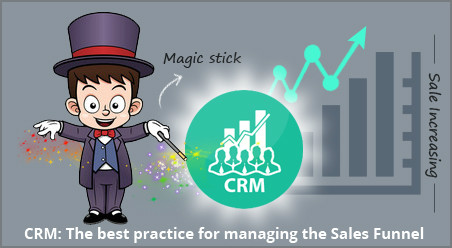In running a business, there are a million and one things to manage. But what tops the priority list is sales. Regardless of the fact how well your marketing campaigns are performing, how good your manufacturing operation is, or how well-defined your operational techniques are – they seem to be useless until and unless your business is not making sales and generating enough revenue.

That’s precisely why maximum of the time, you as an entrepreneur hold meetings and brainstorm sessions to employ the best sales mechanics. The concern is one: whether there are enough leads in the sales funnel and if yes, then how fast are they progressing towards the end?
But having a continuous obsession with an overflowing sales funnel works negatively for a business.
That’s because assuming that the sales funnel will always have leads dropping in relentlessly and speedily moving towards the bottom-line is not correct. Even for the big corporations, their sales funnels do not function in that manner. Leads/prospects do get stuck within the different stages or even exit out of the funnel.
And it is precisely at this juncture that the problem starts. While disorganized sales funnel is typical of both the large and small organizations, the big ones are adept to handle it while the small players grapple with it. That’s because most SMBs do not have the adequate resources to analyze it and get an accurate and deep intuitive understanding.
Need further clarification? Take this example below:
Call your sales and marketing team and ask them the exact number of leads present at every stage of the funnel.
In all probability – your team will find it difficult to answer this question with certainty. Rather what you will get is an assumption of some approximate figures for each stage of the funnel. Needless to say with this type of funnel insight, there is not much that you can do.
What calls for an accurate funnel-visioning?
Fortunately in a time when a slight drop in the sales costs businesses to fall permanently to the wayside – we have the CRM software that prevents the businesses from falling prey to such a bad fortune.
Surprised?
CRM has been around for a long time but their primary focus has been on customer service. However, over the period some reputable vendors have morphed the definition of CRM and extended its functionality to sales and marketing. Today, the new-age CRM solutions have come into the picture moving from a standalone customer management system to a comprehensive and integrated Business Management Platform that monitors all crucial aspects of operations and delivers right from marketing to sales and customer service.
Some of the compelling features integrated within the new-age CRM solutions include – Sales Force Automation, Marketing Automation, Email Marketing, Social integration, Customer Support, Collaboration, Document Management, Project Management, Invoicing and Reports and Analytics.
What they have brought along with these list of features is an accurate visioning of the sales funnel to exactly know how many new leads are at the brim who have just entered the company database, how many have briefly engaged with marketing campaigns and have been lumped together into a mid place and finally how many are getting actively engaged with sales and traversing fast towards the bottom of the funnel.
With an exact knowledge of the number of prospects existing at every stage of the sales process – sales funnel becomes an actionable tool, analyzing which, businesses can plan out the forthcoming lead to deal conversion strategies.
Jane Rivera speaks on this issue – ”Until few years before we have seen businesses do guesswork when it came to the deal closure probability percentage. Based on their own gut feel sales and marketing representatives have predicted the conversion probability. With no hard facts to support these probability percentages, the sales forecasts have been inaccurate and have often missed hitting the set target.”
The magic wand of CRM in transforming the Sales Process
CRM has eliminated the guesswork game and transformed the whole process by ensuring that all sales-qualified leads are converted into customers in a predictable and well-disciplined manner. It has brought in the provision to develop a framework for the sales process and define it in the system. Sales agents can further divide the sales process into a series of observable phases. These phases can be used to track the progress, identify the risks associated and determine what needs to be done to move the leads towards sale.
And in the midst of all this, what has emerged as the icing on the cake is the benefit of sales force automation. Using the built-in feature of automation, it has become possible for the sales agents to automate the execution of activities when certain pipeline conditions are met.
Example – when prospect downloads marketing brochure or on the request of SOW (solution of work). Depending on the requirement, sales agents have the added power to automate the process, making it even easier to accelerate the movement of leads towards the end of the funnel.
Final Takeaway
So every small to medium-sized entrepreneur – it’s time to invest in a new-age CRM. You have two options – either go for a ready-made one or look for service providers specializing in custom application development and get them to build your own tailor-made CRM.
When you start using the CRM you are bound to experience the benefits as mentioned above. There will be complete transparency as to when the prospects are traversing from one phase to another and what are the sales tools that are contributing to this move. Needless to say, it can be a big impetus for your sales team who can track every lead through the funnel and be more precise and focused in their strategies to fast move the leads to the next stage.



![[Research Round-Up] New Study Shows the Continuing Value of B2B Thought Leadership](https://customerthink.com/wp-content/uploads/development-2010010_1280-pixabay-innovation-ideas-think-1-218x150.jpg)